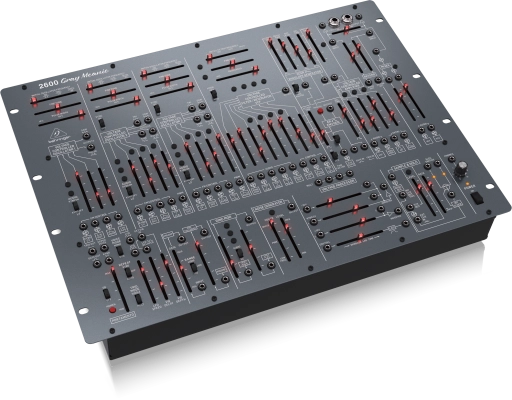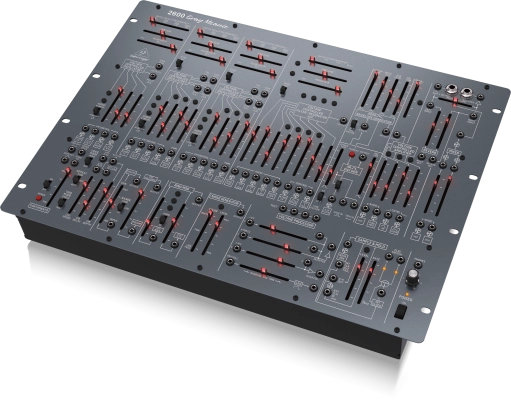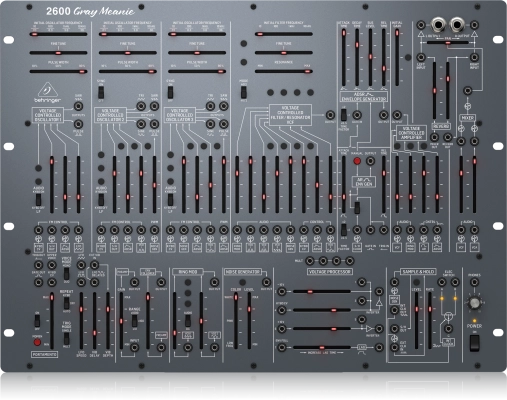Behringer 2600 GRAY MEANIE Special Edition Semi-Modular Analog Synthesizer

Additional Photos:
Great Additions
Description
Now meet the Behringer 2600 GRAY MEANIE, a limited edition, ultra-affordable and even more feature-packed homage to the iconic ARP 2600 synthesizer. Compared to the original Behringer 2600, the GRAY MEANIE features a mechanical spring reverb, hand-picked components, uni-color LEDs on each fader plus a super slick paint job that'll make your setup pop! Conjure up virtually any sound imaginable with incredible finesse and ease. The pure-analog signal path is based on the authentic ARP 2600 circuitry from the '70s with matched transistors and JFETs. Owning a GRAY MEANIE is like having your own piece of history enabling you to re-create timeless classics or forge your own musical path.
True to the Original
Great care has been taken in engineering the GRAY MEANIE's true-to-the-original analog circuitry, semi-modular architecture and triple VCO design, all of which come together to recreate the classic tones evocative of classic electronic music. This highly-focused attention to detail gives the GRAY MEANIE its ultra-flexible sound-shaping capability, which then empowers you to recreate amazing tones from super-fat bass and tasty leads, all the way to full-on dreamy ambience from the far reaches of your imagination.
Big, Fat Tones
The synthesizer tracks laid down in the 1970s and '80s in progressive rock, new wave and synth-pop have become classics and have inspired many other artists. The GRAY MEANIE lets you recreate all that magic or design some incredible and original sounds that will make you a legend in your own right!
Ready to Rock
Just like the original, the GRAY MEANIE is a semi-modular synthesizer that allows you to start making music without having to plug patch cables into different modules. But don't let that stop you, the GRAY MEANIE also features 93 patchable ins and outs, so you can configure the synthesizer any way you want.
Make Waves
The GRAY MEANIE features 3 VCOs with FM inputs. You can even patch the VCOs' default waveforms to square, triangle, saw, sine or pulse, which allows for an awe-inspiring palette of tonal possibilities. Any of the VCOs can also be switched to operate as a low frequency oscillator, while the multi-mode VCF acts as the VCO mixer of the GRAY MEANIE where VCO's one, two and three can be blended. Combine that with its integrated resonance control, filter mode switch and the ability to output to other areas of the synth and the GRAY MEANIE becomes a fantastic and flexible tool for creating a diverse palette of tones that will truly blow away your audience.
The Cherry on Top
To top off the already amazing array of waveforms and mixing capabilities of the GRAY MEANIE, an incredible range of modules and effects are at your disposal including a ring modulator, lag processor, sample and hold, Schmitt trigger, envelope follower, a noise generator with continuously variable color and even a mechanical spring reverb to add spaciousness and a sense of scale to your music. Behringer even included 2 dedicated LFOs with pulse and sine wave outputs.
Time to Attack
With the integrated ADSR and AR envelope generators of the GRAY MEANIE, you can create some truly dynamic progressions in your songs. Set the Attack, Decay, Sustain and Release low to get short and softer sounding notes then slowly slide the faders up; opening your notes to give your song some tension before that big drop everyones been waiting for. If simple ADSR controls are not enough, then you can get even more creative by flipping the Time Factor switch to either x2, x1 or x0.5. This control gives you more control over the shape of the envelope, so you can have notes that are short and percussive or long and atmospheric.
Shape Your Tone
The VCA section of the GRAY MEANIE offers even more tone-shaping possibilities alongside the VCF which can then be blended in the Mixer section. Within the VCA section, you can set the initial gain of the circuit and route signals to any of the input jacks and adjust the gain using the sliders. The VCA also features differential inputs for both linear and exponential response which accept control voltage signals via 3.5 mm jacks.
Controls and Connectivity
We just can't help ourselves like you, we're gear heads too! So for those who want the numbers, the GRAY MEANIE has 78 faders and buttons, all laid out in a highly-intuitive format that puts the joy back into your music creation.
Unleash Your Imagination
When it comes to recreating the classic sounds of a classic era like the 1970s and '80s, with a few modern features, there's nothing like the Behringer 2600 GRAY MEANIE; portable and so very affordable.
Features
• Amazing analog synthesizer with triple VCO design allows for insanely fat music creation• Authentic reproduction of ultra-rare ARP Grey Meanie circuitry from the '70s with specially selected opamps and transistors
• Semi-modular architecture requires no patching for immediate performance
• 3 VCOs, each with LFO mode, FM inputs and multiple wave-shape outputs for an awe-inspiring palette of tonal possibilities
• Multi-mode VCF with dedicated low-pass output and additional switched high/notch output
• Incredible range of modules including ring modulator, lag processor, sample & hold, Schmitt trigger, and envelope follower
• ADSR and AR envelope generators with switchable time factor
• Fitted with a mechanical spring reverb for inspiring sound effects
• Noise Generator with continuously variable color
• 2 dedicated LFOs with pulse and sine wave outputs
• Switched Post Filter Distortion (PFD) / Inverter option on voltage processor
• Differential (+/-) input VCA with both linear and exponential control inputs
• Additional functions include attenuator, mixer, inverter, slew rate limiter and 4-way multiple for creative patching flexibility
• External audio input for processing of external sound sources
• 78 controls give you hands-on direct and real time access to all parameters
• 93 patchable inputs/outputs for the ultimate in configuration flexibility
• Comprehensive MIDI implementation with MIDI channel and Voice Priority selection
Q & A
- asked on Oct 18, 2024
- answered by Ron Elliott, Burlington, Ontario
- asked on Jan 10, 2025
- answered by Ron Elliott, Burlington, Ontario
Reviews

Protect your investment with the Long & McQuade Performance Warranty
A warranty can be a very important factor when making a buying decision. Because repairs can be very expensive in terms of parts and labour costs, manufacturers usually only provide one year limited warranties that generally only cover items that malfunction due to a manufacturer’s defect. With an important purchase such as a musical
instrument or piece of studio gear, however, many people want to have the peace of mind in knowing that their investment will be protected should the product no longer be performing at 100%.
Because of this, Long & McQuade provides our customers with a FREE one-year Performance Warranty on most of our products. The Long & McQuade Performance Warranty supplements the manufacturer’s warranty to ensure that our customers receive complete “no hassle” warranty coverage within their first year.
How does the Long & McQuade Performance Warranty differ from most manufacturers' warranties?
- Performance Guarantee: Normal wear and tear is covered, so your product will be performing as well as the day you purchased it for the entire duration of the coverage. Band and Orchestral Performance Warranty does not include replacing pads or cleaning for woodwind instruments, unless deemed necessary by our repair staff. Ultrasonic cleaning for brass instruments will be provided if deemed necessary by our repair staff, but is not routinely offered under the Performance Warranty.
- Product Replacement: If your product cannot be fixed or costs too much to fix, we will replace it with the equivalent model for no additional charge. If this is not possible, a full refund will be provided.
- No Lemon Policy: Your product will be replaced should the same problem occur multiple times.
- Convenient: Easy drop off and pick up of the product at any Long & McQuade location.
- Guitar Setup: Guitars purchased at Long & McQuade come with 1 free setup, to be redeemed within 1 year for new guitars and 90 days for used guitars.
- Loaners Available: A loaner product may be given while the product is being repaired.
- Power Surge Protection: Your product is covered even if damaged from a power surge.
- Accessory Coverage: Any peripheral devices or accessories that come with your product (i.e. foot pedal, case) are also covered.
- Commercial Use Coverage: Music and recording professionals who purchase gear for “heavy-use” commercial purposes will still be covered.
Long & McQuade reserves the right to restrict the purchase of additional years of Performance Warranty. Used products come with a 3-month Long & McQuade Performance Warranty. Some products (i.e. computers, software, cymbals and other items) are covered only by the manufacturer‘s warranty. Consumables (i.e. strings, reeds, drum sticks, batteries, tubes, cross faders) are excluded as they are designed to be replaced. Cosmetic Damage, Accidental Damage, or problems caused by Humidity or Temperature Issues are not covered. Speakers damaged by overpowering are generally not covered. Our coverage does not provide compensation for loss of use. As of June 2018 the Performance Warranty is no longer transferable. The warranty is only valid in Canada.
Purchasing additional years of coverage
Some manufacturers provide warranties for longer than 1 year; however, these are usually limited warranties that do not provide the same coverage as the Long & McQuade Performance Warranty. Customers interested in more complete and convenient (but not necessarily longer) coverage are still able to purchase additional years of the Performance Warranty.
If you are interested in receiving this coverage for longer than one year, you have the option of purchasing additional years of the Performance Warranty. The pricing is as follows:
- NEW products: Starting at 4% of the current new selling price to double the warranty from 1 year to 2 years. Starting at 4% for each additional year.
- USED products: Starting at 4% of the current new selling price to increase the warranty from 3 months to 1 year. Starting at 4% for each additional year.
- GUITARS: 4% of the current new selling price to double the warranty from 1 year to 2 years. 4% for each additional year. $45 maximum. An additional free setup is not included with additional purchased years of Performance Warranty.
- BAND and ORCHESTRAL instruments: 4% of the current new selling price to double the warranty from 1 year to 2 years. 4% for each additional year.










